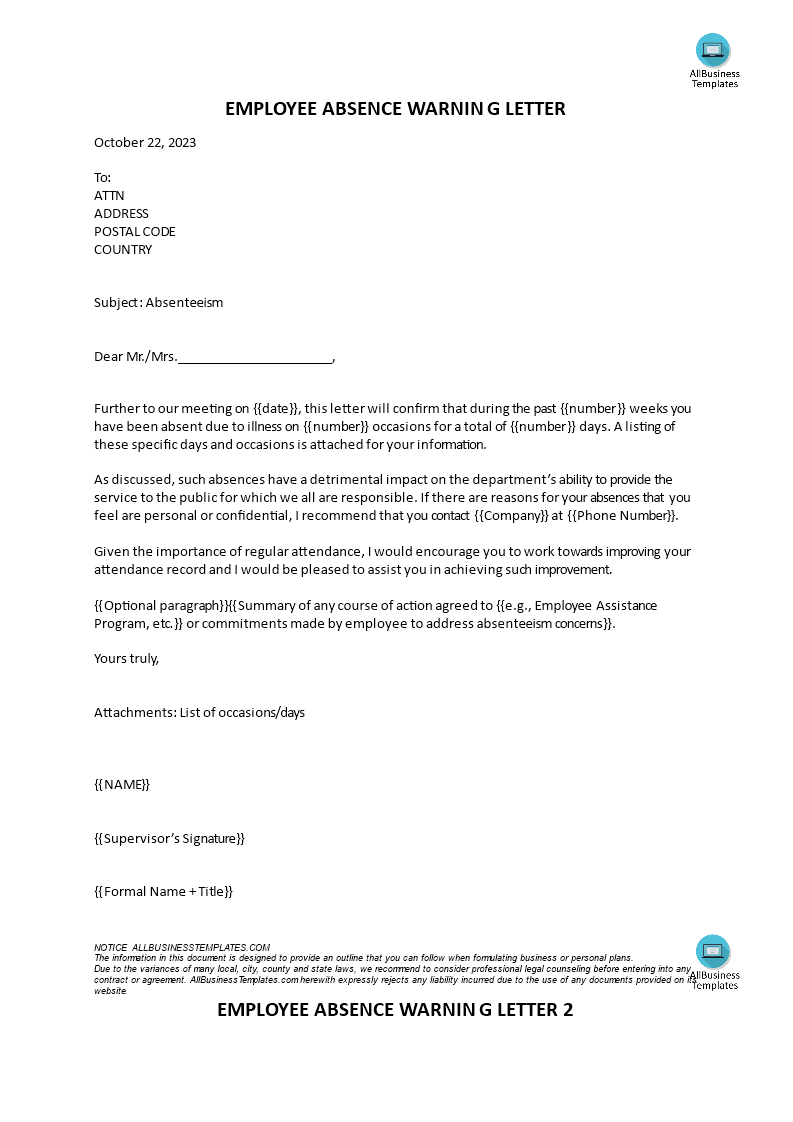Employee Absence Warning
Save, fill-In The Blanks, Print, Done!

Download Employee Absence Warning
Microsoft Word (.docx)Or select the format you want and we convert it for you for free:
- This Document Has Been Certified by a Professional
- 100% customizable
- This is a digital download (28.12 kB)
- Language: English
- We recommend downloading this file onto your computer.
How to draft an employee absence warning? Why do employers send warning letters to their employees? Get this sample letter template which can be used to inform an employee of their absence from work and to inform them of any consequences of their continued absence. Download this employee absence warning template now!
An employee absence warning letter is a formal document issued by an employer to an employee who has exceeded or violated the company's established attendance or absence policy. This letter is typically used as part of the progressive discipline process to address excessive absenteeism, unexcused absences, or patterns of frequent tardiness. The primary purpose of this letter is to inform the employee of their attendance issues, remind them of the company's attendance policies, and outline the potential consequences if the issues persist.
Key elements commonly found in an employee absence warning letter include:
- Employee Information: The letter typically begins with the employee's name, employee ID or number, department, and job title.
- Date: The date when the letter is issued.
- Sender Information: The name, title, and contact information of the employer, supervisor, or HR representative who is issuing the letter.
- Statement of Purpose: A clear statement explaining the purpose of the letter, which is to address the employee's attendance or absence-related issues.
- Attendance History: A summary of the employee's recent attendance record, including the dates and reasons for absences or tardiness. This helps the employee understand the context of the warning.
- Reference to Company Policy: A reference to the company's attendance or absence policy, along with any relevant sections, to remind the employee of the established rules and expectations.
- Violation Description: Specify the specific violations or issues that have occurred, such as excessive unexcused absences, patterns of tardiness, or any other relevant attendance problems.
- Consequences: Explain the potential consequences if the attendance issues persist. This may include disciplinary actions such as further warnings, suspension, or termination.
- Expectations: Clearly state the company's expectations regarding the employee's attendance and the need for immediate improvement.
- Support and Resources: Mention any available support or resources that the company may offer to help the employee improve their attendance, such as employee assistance programs (EAPs) or flexible scheduling options.
- Timeline: Set a specific timeline or deadline for the employee to make improvements and adhere to the attendance policy.
- Signature: The letter should be signed by the issuing authority (e.g., supervisor, HR manager), along with their title.
Employee absence warning letters are an important tool in addressing attendance-related issues and maintaining workplace productivity. They are part of the progressive discipline process, which typically involves a series of warnings and consequences, with the ultimate goal of encouraging employees to improve their attendance and performance. It's important for both employers and employees to keep records of such letters and related communications for future reference and documentation purposes.
Download this human resources employee absence warning template now!
DISCLAIMER
Nothing on this site shall be considered legal advice and no attorney-client relationship is established.
Leave a Reply. If you have any questions or remarks, feel free to post them below.
Related templates
Latest templates
Latest topics
- Excel Templates
Where do I find templates for Excel? How do I create a template in Excel? Check these editable and printable Excel Templates and download them directly! - GDPR Compliance Templates
What do you need to become GDPR compliant? Are you looking for useful GDPR document templates to make you compliant? All these compliance documents will be available to download instantly... - Google Docs Templates
How to create documents in Google Docs? We provide Google Docs compatible template and these are the reasons why it's useful to work with Google Docs... - IT Security Standards Kit
What are IT Security Standards? Check out our collection of this newly updated IT Security Kit Standard templates, including policies, controls, processes, checklists, procedures and other documents. - Letter Format
How to format a letter? Here is a brief overview of common letter formats and templates in USA and UK and get inspirited immediately!
cheese

